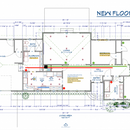Feedback on ERV Vent Locations
Hello,
I’m beginning a remodel on a single-story 1,600 sq/ft ranch and I’m looking for feedback on my proposed ERV vent locations. I’m looking at a RenewAire EV130, EV200 or EV Premium M.
General concerns are making sure there is decent CFM in the bedrooms due to the long run. The actual unit will be placed in a utility closet at the other end of the house. Either in the closet or mounted in the crawl space just next to the crawl space access (in the same closet). Again, looking to avoid bends/elbows.
Is a bathroom exhaust a must? I was also thinking about just having two exhausts instead. One on the west where it is now to catch attached garage containments (plus bathroom, mudroom, and kitchen) and one in the main hallway on the east by all the bedrooms.
Red = Exhaust, Green = Fresh Air
Ducts will be run through a crawlspace. I want to have the exhaust near the ceiling, but am thinking of keeping the fresh air near the floor (on the wall, but am open to floor vents too). I’m trying to keep all ducts as straight as possible — especially the main trunk.
Any thoughts or experience would be greatly appreciated.
Thanks!
GBA Detail Library
A collection of one thousand construction details organized by climate and house part










Replies
You need a bathroom exhaust. It can be a separate exhaust fan, but it makes more sense to make it part of the ERV system, especially if it's a new build. Ideally you want your fresh air vents on the opposite side of the room to the nearest exhaust pick up. Right beside the door to which the direction of airflow is going is not ideal. It's a good idea for every room that can be completely closed with a door have either an exhaust or supply. The kitchen should definitely have an exhaust.
Thank you for the feedback.
Is it generally fresh air down by the floor on the wall and exhaust up near the ceiling on the wall?
Also, you mean an ERV exhaust in the kitchen? It's a pretty small galley kitchen so not sure where to fit it. I was hoping having an exhaust at each entryway would help exhausting kitchen air.
ERV to exhaust general smells and humidity from the kitchen, not to replace a vent hood.
Does the ERV work 24/7, or does it only run a portion of the time?
If it runs all the time, location is less of a problem because in a course of the day, the air will mix and flow in and out. It doesn't work on a hot/cold principle like heat or A/C, it should be relatively close in temperature to the room air and mix well. Cross flow in a room wouldn't hurt, but not hyper critical.
What type of ducting are you using?
The HVAC contractor I talked to yesterday said they use 6" ducts. I asked about 8" and he said 7" is the max they do.
If you are in a mostly heating climate, you want to have the ERV fresh air supply registers near the ceiling. The best is up high on the wall blowing along the ceiling not directly at people.
When it is cold out, the fresh air supply will always be bellow room temperature, if this air is supplied near the floor it will stratify there and you'll get a cold floor.
Stale air pickups don't matter much, they can be anywhere where it is convenient. If you are in radon country it makes sense to have a stale air pickup near the ground in the basement. I like to put the bathroom stale air pickup right above the throne to help with air pollution.
Long runs are not a problem provided you size them correctly. Most of the losses are always at the fittings and bends, length adds a bit but not as much as restrictive fittings. Typical ERV flow rates are so low that you won't have trouble even with 4" flex home runs from any bedroom.
If a crawlspace was being encapsulated — does it make sense to have a single fresh air and stale air register on opposite ends of the crawlspace. Or is that usually handled separately?
Depends on how clean and dry the crawlspace is. If it is generally clean and dry and well encapsulated, intake and exhaust on opposite ends of the crawl will probably be all the conditioning it needs. If all of the above conditions are not met, a dedicated dehumidifier might be a better choice.
It's fairly dry sand on the floor. Crazy dusty, but no signs of water on the block or musty smells.
One thing I found very weird is that each room has its own block foundation. Meaning every wall in the house has concrete block under it — It's not just an open space. Then to connect them is a narrow space in the block. Has anyone heard/seen that before? That was new to me and the HVAC guy.
I think a better option for any encapsulated crawlspace is putting only a stale air pickup sized for the amount venting required by code.
This will vent any smells/dust/radon outdoors and draw in conditioned air from the space above.
A fresh air supply from the ERV is not a good idea as the fresh air will tend to be in the winter colder than the house and in the summer warmer and more humid. This is the opposite of what you want in the crawlspace.
If the crawlspace is cut up without a clear air path, it will need a number of smaller stale air pickups in each section.
A properly conditioned and sealed crawlspace is a happy crawlspace.